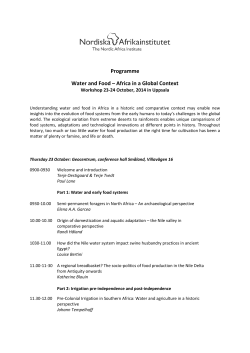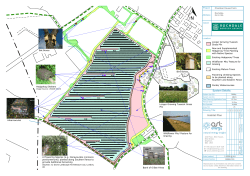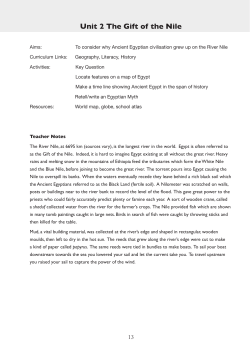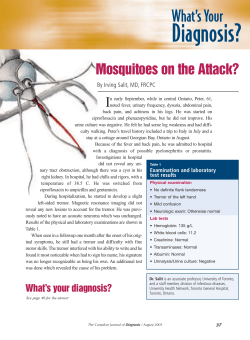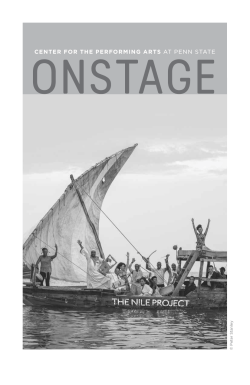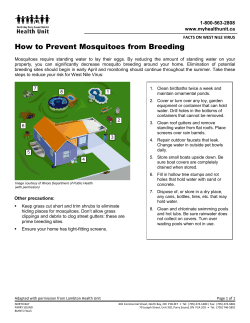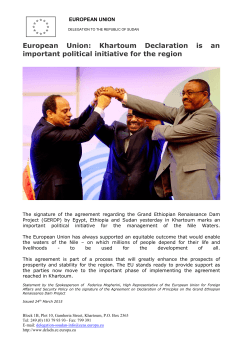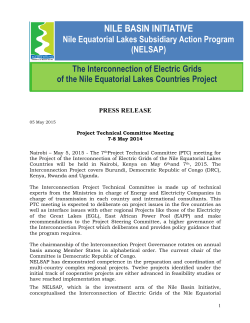
Red Nile: A Biography of the World`s Greatest
1 Red Nile: A Biography of the World’s Greatest River. By Robert Twigger London Weidenfeld & Nicolson 2013. 466 pages Reviewed by Garry Victor Hill A biography of a river seems an underused idea, but it also seems to be one full of dangerous choices. Emphasis and interest can easily go astray. One obvious and boring way to do this would be to put in book form something very similar to those television documentaries where the the voice of the narrator, emerges as the only human aspect The voice explains landscapes, flora, fauna, climate, the effect of seasons - in fact everything to do with science and geography, but nothing about the river dwelling people. The other extreme would be to have the river gradually develop into a backdrop setting for events involving ‘Famous People Who Have Visited the Nile.’ This would be biography indeed, but celebrity biography in disguise. Fortunately Robert Twigger avoids both these extremes and keeps both a sense of balance and of proportion. Chronologically and geographically the river’s life began around twelve thousand years ago. Twigger continues the story up to the 2011 Arab spring revolution, which he witnessed, vividly describes and astutely 2 analyses. That continuity makes for a panorama where he entwines the human developments along the Nile’s banks with the changing geography of the river, starting from its sources in central Africa to the Mediterranean delta. Many maps of the Nile stop at Egypt’s borders and few delineate the Blue Nile or show the Nile flowing out from different lakes in central East Africa. In Red Nile Robert Twigger does deal with the question of where the Nile actually starts. He tells of the continuous interrelationship between river and people, from the first tribal settlers to the latest attempts to use the Nile for irrigation and damming. Several parts of the book are taken up with such attempts from the times of the Pharaohs onwards: their effects were usually disappointing and sometimes disastrous. The Aswan dam disaster remains only the most publicised amongst them. Twigger writes of developments in this entwining process of people and population in ways that are welcomingly unexpected. For example the word papyrus conjures up an image of the plant almost choking the Nile delta: the reality 3 was that the Nile papyrus was extinct in the 1950s and had to be reintroduced. Another section deals with Egypt’s poisonous plants. We are told what they are, and of their effects – and how they were used in politics to kill off rivals, from ancient times onwards. Twigger’s sense of proportion and balance also applies to what initially seems an obviously easy question: where does the Nile actually start? He concludes that the White Nile starts with the flow out from Lake Edward, but notes that there are other small streams flowing into and out of that lake and other nearby feeders interact with lakes, streams and rivers. His sense of proportion and balance also applies to time and to eras. The Ancient Egyptians are dealt with, but they do not predominate. Life has indeed gone on since Cleopatra died. In his An Egyptian Journal (1985) English novelist William Golding made the point that Westerners see Egypt in terms of the empire of the Pharaohs when they should be seeing it as a modern Arab country with a long history of being exactly that. Twigger does not make that mistake. Egypt has been a predominantly Moslem country for nearly fourteen hundred years and he not only writes of his extensive personal observations based in many years of living along the Nile, but he writes with insight into ethnic Arab and Moslem history. He includes the well-known outsiders who became rulers of Egypt and lived lives out of adventure novels: notably Saladin and Baiburs who started out as a bodyguard and ended up ruling an empire are notable examples. Egypt had a way of being ruled by foreignors. Sa;adin was a Kurd from what is now Iraq, Barburs was a Kazakh from the Crimea and after them Egypt was ruled by the Marmalukes for the Turkish Ottomans, the French and the British. Twiggers also finds the less famous who should be Less well known than Saladin and Barburs but from the time of Medieval Arab rule are two of the founders of modern medicine, the expatriate Spanish Jew Maimonides and AlNafis. In one of his important but little known achievements (at least in the West) Al-Nafis accurately and in detail wrote of how blood circulates four hundred years before William Harvey did. Harvey got the credit, at least in the Western world. Maimonides would work for Saladin in several fields. Today his reputation rests on his writings as an innovative doctor and a man of medicine, as a theologian and a philosopher. Another danger within Twigger’s topic concerns writing about the famous and much written about English on the Nile. Doctor Livingston, Richard Burton 4 and Speke, General Gordon, Lord Wolseley, Lord Kitchener,... They have already got massive literary coverage in such works as Winston Churchill’s The River War (1899), Alan Moorehead’s The White Nile (1960) and The Blue Nile (1962) and Michael Asher’s Khartoum: The Ultimate Imperial Adventure (2005). Several large sections in other works also cover these people and the events that they were involved in. Such works include Fawn M. Brodie’s The Devil Drives: A Life of Sir Richard Burton (1967), Brian Gardener’s Allenby (1965), Phillip Warner’s Kitchener: the Man Behind the Legend (1985) and Thomas Parkenham’s The Scramble For Africa 1876-1912. (1991). Howard Carter has probably had more works and documentaries about his life than any of the others just mentioned. Two underused aspects of the Westerners on the Nile concern touring writers Flaubert and Agatha Christie, both get interesting and sometimes witty segments. “Egypt is a nation five kilometres wide and two thousand kilometres long.” In some parts it is not even that. Here a few metres from the Nile the desert starts. Twigger does include these people and the events on the Nile that made them important there, but does not allow his treatment of them to become a prolonged retelling. He says little of the political turmoil that started in the 1920s and continued into the 1950s. This conflict was between the various individuals representing imperialists, nationalists and royalists who vied to control the Nile and therefore Egypt. This convoluted, complicated and prolonged struggle probably deserves another book as large as this one. As part of this development Twigger includes a section on Sadat’s active youthful support for Hitler, an aspect of his career that deserves detail. A section on the architecturally magnificent Shepheard’s Hotel, the most luxurious in the Middle East would have been good. It 5 was located on the Nile in Cairo and served as the heart of British Imperialism in the Middle East. An Egyptian mob burnt it down during the independence Revolution of 1952. The last sections of his book are pensive as he writes of the ecological, demographic, financial and social pressures that Mubarak could not contain and so they lead to Egypt’s Arab spring. Twigger does not give easy answers and there seems to be none. The Nile however, despite ecological poison, despite damming and population pressures will continue to flow – but through what? *
© Copyright 2025

